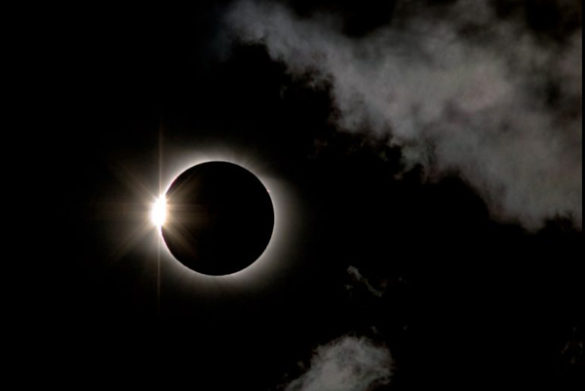
We’re all going to be tempted to take photos or video of the total eclipse, but Vanderbilt Dyer Observatory astronomer Billy Teets says not to bother. “It is very difficult to get a good image of a total eclipse. Due to the continually changing light levels, really good total solar eclipse images require multiple exposures and a fair amount of post-processing,” he said. “You don’t want to be fiddling with your camera instead of really experiencing this once-in-a-lifetime event with your own eyes.” Instead, he suggests pointing your camera at the ground to capture two eclipse-related phenomena: pinhole projection of the partial eclipse and the mysterious shadow bands.
Both pinhole projections and shadow bands can be safely photographed and filmed. “These are much easier to photograph than the total solar eclipse, and you also don’t run the risk of damaging your camera. Besides, you have precious seconds to view the total solar eclipse, so don’t focus on trying to photograph that,” Teets says. “The partial eclipse phases, which last for about 90 minutes before and after totality, are easier to photograph and you have much more time to appreciate them while doing so. ”
For both, start by finding a solid white or light-colored surface on the ground, like concrete, or making your own by spreading out a white sheet or poster board.
Pinhole projection
A pinhole projector is a great way to indirectly view a partial solar eclipse—and is one of only a few ways to safely view the partial solar eclipse without the need for eye protection. (More on viewing safety)
“You take a large piece of cardboard and punch a small hole about the size a pencil eraser in the center,” he said. Hold the cardboard flat a few feet above your light-colored surface so the hole casts a small circle of light within the shadow cast by the cardboard. As the moon begins to pass in front of the sun, you’ll be able to see a round shadow slowly encroaching upon the circle of light, turning it into a crescent that gradually grows thinner and thinner. Once the sun is fully eclipsed, Teets says, you can safely look up at the sky without eye protection. But as soon as the sun starts to appear again, you need to go back to watching your projection.
For a neat effect, you could poke multiple holes in your projector, or even use something like pegboard or a colander, Teets says, as each circle will project its own separate eclipse. “Keep in mind that you’re supposed to be watching the dot of light you’re projecting on the ground,” Teets warns. “Do not try to watch the sun through your projector. Observing the sun even through a pinhole-sized opening will cause eye damage.”
You could even use an unfiltered telescope to project the partial eclipse onto a screen—but Teets says not to use one you’re particularly attached to. “It can permanently damage the lens, so use an old telescope or go buy a cheap one for this,” he said. “Also, make sure that nobody looks into the telescope eyepiece—this would result in instant and severe eye damage.”
Shadow bands
Another thing to look for are shadow bands, which are mysterious wavy shadows observed just before and after total eclipses. “Imagine the ripples of light you see at the bottom of the pool,” Teets says. “The same principle applies here. In a swimming pool, the changing shape of the water’s surface easily deflects sunlight, creating a bright rippling effect. The atmosphere does the same thing.” We normally can’t detect shadow bands, Teets says, because our atmosphere is much less dense than water and the sun is so big and bright that it overwhelms the effect. But once the sun is almost completely eclipsed, they become visible. (Learn more about the science of shadow bands from NASA)
You don’t need any equipment to see shadow bands except your solid, light-colored surface, Teets says. About a minute before totality—approximately 1:26 p.m. here in Nashville—you’ll begin to see faint ripples of light appear. They’ll continue until totality and afterward reappear for about a minute.